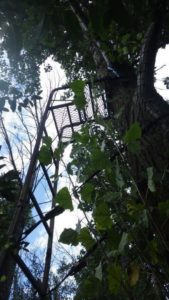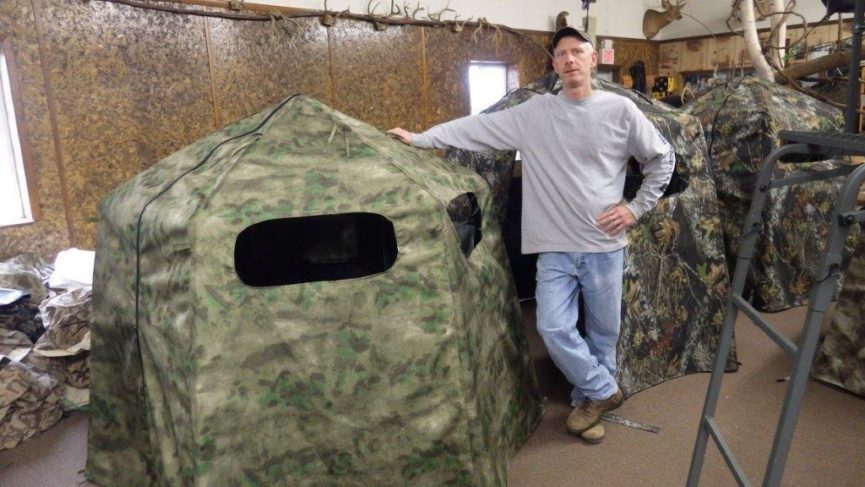 By: Tom Lounsbury.
By: Tom Lounsbury.
Ever since my wife Ginny and I became the 4th generation to own the family farm 20 years ago, we’ve put a lot of effort since then into creating our own little wildlife paradise, thanks to various conservation programs our farm is enrolled in. My main focus is providing proper habitat for wild pheasants, and in so doing it has worked to the benefit of all wildlife, including deer. The majority of the farm entails prairie grass fields, which have evergreen windbreaks all around the outer perimeter, and it didn’t take long for me to realize the very adaptable whitetails absolutely love prairie grass and are readily attracted to it (it has proven to be a preferred and ideal “nursery” for does and fawns). Figuring out how to effectively hunt deer each fall in this mainly grassy environment has been a steady learning experience I much enjoy.
Typically, I’ve found being up above the ground and getting a bird’s eye view is the best way to go for stand placement, and I’m fortunate in that many of my windbreak trees have finally gotten large enough to place stands in them, as well as I have some mature hardwood trees here and there along our ditch and fencerows. However, I had one special location which required something different for obtaining some elevation, and a couple years ago I purchased a two-person tri-pod stand. I remember it required two healthy young men just to lift it, still boxed up, into my pickup bed.
I left it in my truck until my son Jake could help me unload and assemble it right at the hunting site amongst some young spruces bordering the prairie grass. This was definitely a two person job, from following a chart and assembling all the countless pieces, to actually raising it upright into position. According to the directions, the putting-it-all-together time would only take “90 minutes”, but that timeline must have been for a crew of people who knew which part and exactly which bolt (of which there were many different sizes) went where. I’m guessing it took Jake and I at least four hours to put it together and then stand it upright, but it was well worth the effort as it has proven to be an ideal setup for that location.
This all points out to the fact that preseason readiness often requires a little extra hand and teamwork, not only for convenience, but certainly for safety as well. Personally, I’m not into free-hanging tree-stands and I much prefer ladder-stands because they are still connected to the ground which is also supporting most of the weight. Originally I used one-person ladder-stands for my sons and I, but with grandchildren (and other kids of course) coming into the picture who must (and should) be accompanied by an adult, I’ve been going to the two-person variety whenever possible, and if hunting alone, I certainly don’t mind the extra space at all.
Putting up the typical one-person ladder-stand in my opinion requires at least two people, and I prefer three for additional safety (I’m sure there are some muscular and independent types who feel they can do matters singlehanded, but I’ve had enough thrills already in my life challenging gravity, and I don’t bounce too well anymore either). The only one-person ladder-stand I’m aware of which requires only one person for easy setup and takedown is locally made by Lucky’s Hunting Blinds (www.luckyshuntingblinds.com) of Ubly, called the “Crab Claw”. I’ve been using one for a couple seasons now and it is very sturdy (it is the most sturdy I have ever been in) and works exactly as advertised, and can be easily and quickly moved singlehanded to a different location.
Two or better yet, three people should always be on hand for setting up the two-person ladder-stands.
Where allowed on private property, I often leave my ladder-stands in place all year if they are in a good hunting site (especially near dependable travel corridors and notable pinch-points), as it saves having to deal with matters, and I’ve found quality metal stands tend to be quite weather durable. However due to annual tree growth (and weather/storms), I check them well before opening day to see if they need resetting and new nylon ratchet straps (I buy plenty of ratchet straps and have them on hand for this purpose). Besides annual tree growth, there is also dry rot caused by continual exposure to weather and the sun’s rays that affects the integrity of tough nylon.
When it comes to chains which are more weather durable than nylon, I’ve seen annual tree growth actually weaken and even separate heavy duty steel links. I also have a wooden platform I lag-bolted between cottonwood trees near my pond, and it was quite sturdy. I had high hopes of even completing it into a tree-house/blind but that all got dashed this summer. Cottonwoods being cottonwoods, and with all the rain this spring and summer, they did some serious growing, and while the lag-bolts held firm, the (treated lumber) boards they were holding didn’t, causing the boards to start splitting. So it is definitely a real good idea to double check any “permanent” wooden hunting stands bolted or nailed into trees, no matter how well built.
Hunting blinds I do put up and take down each year are my portable and dependable Lucky’s Ground Blinds and I like to do this in certain spots well ahead of time to let deer readily adjust to them. Then there is my wooden deer “shack” blind that I just discovered raccoons have been using as a playroom (and “litter-box”) all summer after breaking in through a window, and the roof certainly needs some repairs too. Yes, my hands are full right now, but it is all a part of the picture and the anticipation of the hunting shared with family and friends is what makes it all very worthwhile, and admittedly, I really do enjoy this preseason stuff.
This also includes scouting to understand what deer are hanging around in my hunting area, and I’ve been doing this whenever possible all summer. Bucks are usually in bachelor groups throughout the summer and well into September (sometimes there is a solitary buck out there, and these do perk up my attention because they usually have been around awhile and are a bit more moody and less social than the rest).
The scouting process gives me an idea of where the deer overall are feeding regularly, and this is important to when I (try to) pattern certain bucks (and why blinds/stands are located where they are). For me at least, the buck-patterning process (per food sources and bedding areas) can work during the early archery season right up until the peak of the rut starts easing in, then matters can turn topsy-turvy when bucks go on the move and some even seek different pastures in their pursuit of does. This is when knowing doe-patterns really helps, because where there are does, bucks aren’t far away.
I’ve actually taken some nice bucks during the peak rut that I was never aware were around before, and I’m sure some were possibly transients from a ways away. Here in the Thumb, the annual fall harvest of farm crops can cause a quick change in deer patterns as well.
Trail-cameras certainly aid in the scouting process and I fully appreciate what they can do and have plenty of friends who use them. However, I’m none too high-tech with some matters and I have yet to give trail-cameras a personal whirl. I still rely on the old school tactics of “reading deer sign” (tracks, droppings, well-worn trails, scrapes and rubs) and glassing from afar with binoculars. So far, it has always worked plenty fine for me.
With summer winding down, the deer seasons are actually not that far away (I’ve already “adopted” a kid for the mid-September Youth Hunt) and I plan on being fully prepared before it gets here, and I do love it so.

